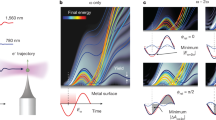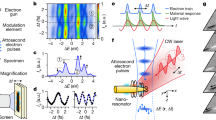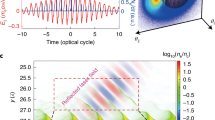Abstract
An advanced understanding of ultrafast coherent electron dynamics is necessary for the application of submicrometre devices under a non-equilibrium drive to quantum technology, including on-demand single-electron sources1, electron quantum optics2,3,4, qubit control5,6,7, quantum sensing8,9 and quantum metrology10. Although electron dynamics along an extended channel has been studied extensively2,3,4,11, it is hard to capture the electron motion inside submicrometre devices. The frequency of the internal, coherent dynamics is typically higher than 100 GHz, beyond the state-of-the-art experimental bandwidth of less than 10 GHz (refs. 6,12,13). Although the dynamics can be detected by means of a surface-acoustic-wave quantum dot14, this method does not allow for a time-resolved detection. Here we theoretically and experimentally demonstrate how we can observe the internal dynamics in a silicon single-electron source that comprises a dynamic quantum dot in an effective time-resolved fashion with picosecond resolution using a resonant level as a detector. The experimental observations and the simulations with realistic parameters show that a non-adiabatically excited electron wave packet15 spatially oscillates quantum coherently at ~250 GHz inside the source at 4.2 K. The developed technique may, in future, enable the detection of fast dynamics in cavities, the control of non-adiabatic excitations15 or a single-electron source that emits engineered wave packets16. With such achievements, high-fidelity initialization of flying qubits5, high-resolution and high-speed electromagnetic-field sensing8 and high-accuracy current sources17 may become possible.
This is a preview of subscription content, access via your institution
Access options
Access Nature and 54 other Nature Portfolio journals
Get Nature+, our best-value online-access subscription
$29.99 / 30 days
cancel any time
Subscribe to this journal
Receive 12 print issues and online access
$259.00 per year
only $21.58 per issue
Buy this article
- Purchase on Springer Link
- Instant access to full article PDF
Prices may be subject to local taxes which are calculated during checkout





Similar content being viewed by others
Data availability
The data that support the plots within this paper and other findings of this study are available from the corresponding authors upon reasonable request.
Code availability
The computer codes that support the plots within this paper and other findings of this study are available from the corresponding authors upon reasonable request.
References
Bäuerle, C. et al. Coherent control of single electrons: a review of current progress. Rep. Prog. Phys. 81, 056503 (2018).
Bocquillon, E. et al. Electron quantum optics: partitioning electrons one by one. Phys. Rev. Lett. 108, 196803 (2012).
Jullien, T. et al. Quantum tomography of an electron. Nature 514, 603–607 (2014).
Ubbelohde, N. et al. Partitioning of on-demand electron pairs. Nat. Nanotechnol. 10, 46–49 (2015).
Yamamoto, M. et al. Electrical control of a solid-state flying qubit. Nat. Nanotechnol. 7, 247–251 (2012).
Hayashi, T., Fujisawa, T., Cheong, H. D., Jeong, Y. H. & Hirayama, Y. Coherent manipulation of electronic states in a double quantum dot. Phys. Rev. Lett. 91, 226804 (2003).
Koppens, F. H. L. et al. Driven coherent oscillations of a single electron spin in a quantum dot. Nature 442, 766–771 (2006).
Johnson, N. et al. Ultrafast voltage sampling using single-electron wavepackets. Appl. Phys. Lett. 110, 102105 (2017).
Degen, C. L., Reinhard, F. & Cappellaro, P. Quantum sensing. Rev. Mod. Phys. 89, 035002 (2017).
Pekola, J. P. et al. Single-electron current sources: toward a refined definition of the ampere. Rev. Mod. Phys. 85, 1421 (2013).
Johnson, N. et al. LO-phonon emission rate of hot electrons from an on-demand single-electron source in a GaAs/AlGaAs heterostructure. Phys. Rev. Lett. 121, 137703 (2018).
Petersson, K. D., Petta, J. R., Lu, H. & Gossard, A. C. Quantum coherence in a one-electron semiconductor charge qubit. Phys. Rev. Lett. 105, 246804 (2010).
Kim, D. et al. Microwave-driven coherent operation of a semiconductor quantum dot charge qubit. Nat. Nanotechnol. 10, 243–247 (2015).
Kataoka, M. et al. Coherent time evolution of a single-electron wave function. Phys. Rev. Lett. 102, 156801 (2009).
Kataoka, M. et al. Tunable nonadiabatic excitation in a single-electron quantum dot. Phys. Rev. Lett. 106, 126801 (2011).
Ryu, S., Kataoka, M. & Sim, H.-S. Ultrafast emission and detection of a single-electron Gaussian wave packet: a theoretical study. Phys. Rev. Lett. 117, 146802 (2016).
Giblin, S. P. et al. Evidence for universality of tunable-barrier electron pumps. Metrologia 56, 044004 (2019).
Kaestner, B. & Kashcheyevs, V. Non-adiabatic quantized charge pumping with tunable-barrier quantum dots: a review of current progress. Rep. Prog. Phys. 78, 103901 (2015).
Kashcheyevs, V. & Kaestner, B. Universal decay cascade model for dynamic quantum dot initialization. Phys. Rev. Lett. 104, 186805 (2010).
Friesen, M., Chutia, S., Tahan, C. & Coppersmith, S. N. Valley splitting theory of SiGe/Si/SiGe quantum wells. Phys. Rev. B 75, 115318 (2007).
van der Vaart, N. C. et al. Resonant tunneling through two discrete energy states. Phys. Rev. Lett. 74, 4702–4705 (1995).
Fujiwara, A., Nishiguchi, K. & Ono, Y. Nanoampere charge pump by single-electron ratchet using silicon nanowire metal-oxide-semiconductor field-effect transistor. Appl. Phys. Lett. 92, 042102 (2008).
Yamahata, G., Giblin, S. P., Kataoka, M., Karasawa, T. & Fujiwara, A. Gigahertz single-electron pumping in silicon with an accuracy better than 9.2 parts in 107. Appl. Phys. Lett. 109, 013101 (2016).
Yamahata, G., Nishiguchi, K. & Fujiwara, A. Gigahertz single-trap electron pumps in silicon. Nat. Commun. 5, 5038 (2014).
Yamahata, G., Giblin, S. P., Kataoka, M., Karasawa, T. & Fujiwara, A. High-accuracy current generation in the nanoampere regime from a silicon single-trap electron pump. Sci. Rep. 7, 45137 (2017).
Rossi, A. et al. Gigahertz single-electron pumping mediated by parasitic states. Nano Lett. 18, 4141–4147 (2018).
Fujisawa, T. et al. Spontaneous emission spectrum in double quantum dot devices. Science 282, 932–935 (1998).
Yamahata, G., Karasawa, T. & Fujiwara, A. Gigahertz single-hole transfer in Si tunable-barrier pumps. Appl. Phys. Lett. 106, 023112 (2015).
Weber, C. et al. Probing confined phonon modes by transport through a nanowire double quantum dot. Phys. Rev. Lett. 104, 036801 (2010).
Liang, W. et al. Fabry–Perot interference in a nanotube electron waveguide. Nature 411, 665–669 (2001).
Dupont-Ferrier, E. et al. Coherent coupling of two dopants in a silicon nanowire probed by Landau–Zener–Stückelberg interferometry. Phys. Rev. Lett. 110, 136802 (2013).
Koch, M. et al. Spin read-out in atomic qubits in an all-epitaxial three-dimensional transistor. Nat. Nanotechnol. 14, 137–140 (2019).
Acknowledgements
We thank K. Chida, H. Tanaka, T. Karasawa, S. P. Giblin, J. D. Fletcher and T. J. B. M. Janssen for useful discussions. This work was partly supported by JSPS KAKENHI Grant no. JP18H05258, by the UK Department for Business, Innovation, and Skills and by the EMPIR 15SIB08 e-SI-Amp Project. The latter project has received funding from the EMPIR programme co-financed by the Participating States and from the European Union’s Horizon 2020 research and innovation programme. This work was also supported by the National Research Foundation (Korea NRF) funded by the Korea Government via the SRC Center for Quantum Coherence in Condensed Matter (Grant no.2016R1A5A1008184).
Author information
Authors and Affiliations
Contributions
G.Y. measured the device, analysed the data, and performed the calculation of the pump map. S.R. performed the numerical calculation of the Schrödinger equation. G.Y. and M.K. conceived the idea of the experiment. S.R. and H.-S.S. developed the theory of the coherent dynamics and the scheme for the effective time-resolved detection with picosecond resolution. N.J. took supporting data of the current oscillations. A.F. fabricated the device. All the authors discussed the results. G.Y., S.R. and H.-S.S. wrote the manuscript with feedback from all authors. M.K., A.F. and H.-S.S. supervised the project.
Corresponding authors
Ethics declarations
Competing interests
The authors declare no competing interests.
Additional information
Publisher’s note Springer Nature remains neutral with regard to jurisdictional claims in published maps and institutional affiliations.
Supplementary information
Supplementary Information
Supplementary Sections I–XV, Figs. 1–13, Table 1 and refs. 1–26.
Rights and permissions
About this article
Cite this article
Yamahata, G., Ryu, S., Johnson, N. et al. Picosecond coherent electron motion in a silicon single-electron source. Nat. Nanotechnol. 14, 1019–1023 (2019). https://doi.org/10.1038/s41565-019-0563-2
Received:
Accepted:
Published:
Issue Date:
DOI: https://doi.org/10.1038/s41565-019-0563-2
This article is cited by
-
Beating Carnot efficiency with periodically driven chiral conductors
Nature Communications (2022)
-
Single-electron turnstile stirring quantized heat flow
Nature Nanotechnology (2022)
-
Transport features of topological corner states in honeycomb lattice with multihollow structure
Frontiers of Physics (2022)
-
Phase-space studies of backscattering diffraction of defective Schrödinger cat states
Scientific Reports (2021)
-
Picosecond detection of electron motion
Nature Nanotechnology (2019)



